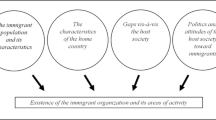Abstract
Immigrants are over half of the new entrants in occupations in southwestern labor markets that range from farmworker to janitor to engineering professor. This paper explains how the availability of immigrant workers changes employment practices in ways that push and pull Americans out of jobs which remain "dirty" or unattractive to U.S. workers. An immigrant network that eventually takes over an enterprise's jobs can begin by accident or design. Accidental immigrant takeovers begin with pioneer workers who persist in high turnover jobs such as seasonal farmworker. These workers offer to bring their friends and relatives to fill vacancies as they occur. Takeovers by design sometimes follow a strike in which immigrants are recruited to be strikebreakers. After immigrants dominate the workforce, the language and culture of the workplace change in ways that make American workers feel out-of-place. Employers feel under no compulsion to upgrade dirty jobs as long as immigrant workers are available, so the technology and productivity of immigrant-enclave jobs tend to be frozen, guaranteeing that dirty jobs get less and less attractive to Americans. Indeed, industries dependent on immigrant workers often turn protectionist when they realize that even low immigrant wages are not sufficient to ensure their survival in the global marketplace. In this way, Americans lose out in several ways: They must compete directly with immigrant workers in the labor market, and then pay higher prices for the goods produced by immigrant workers because the industries preserved by them demand protection from imports. This paper will explore the manner in which immigrant networks displace Americans from dirty jobs and how the availability of immigrant workers can preserve sunset industries which turn protectionist. Examples from fruit and vegetable agriculture, garments, and shoes will be discussed.
Similar content being viewed by others
References
Bailey, Thomas. (Spring 1985). A case study of immigrants in the restaurant industry.Industrial Relations 24, 205–221.
Bernstein, Harry (August 15, 1989).Los Angeles Times, Part IV, p. 19.
Bouvier, Leon & Simcox, David (1986).Many hands, few jobs Washington, D.C: Center for Immigration Studies.
Commission for the Study of International Migration and Cooperative Economic Development. (1990).Unauthorized migration: An economic development response. Washington, D.C.
Cook, Roberta & Shewdel, Ken (January 1992). Mexico frees up investment in agriculture, mimeo.
Cook, Roberta et al., (1991).NAFTA: effects on agriculture. Vol. 4 fruit and vegetable issues Park Ridge, II: American Farm Bureau Foundation.
Cornelius, W. A. (March 1990). Labor migration to the United States: Development outcomes and alternatives in Mexican sending communities, final report to the Commission for the Study of International Migration and Cooperative Economic Development, pp. 81–123. Washington, D.C.
Cornelius, W. A. (June 13, 1991). Free Trade and labor migration: The uncertain connection, Mimeo, UCSD.
General Accounting Office. (1988).Illegal aliens: Influence of illegal workers on wages and working conditions of legal workers. Washington: GAO, PEMD-88-13BR pp. 40–1.
Levy, Sanford (May 1991). Notes on a NAFTA mimeo.
Muller, Thomas & Espenshade, Thomas (1985).The fourth wave: California's newest immigrants. Washington D.C: The Urban Institute.
Murray, Charles (1984).Losing ground: American social policy, 1950–1980. New York: Basic Books.
Robichaux, Mark (August 7, 1989). Entrepreneur training tries to break the welfare chain.Wall Street Journal, p. B1.
U.S. Bureau of the Census (1989).Transitions in income and poverty status. Household and Economic Studies, p. 70, No. 15-RD-1. Washington, D.C: Author.
U.S. Department of Labor (1989).The effects of immigration on the U.S. economy and labor market. Washington, D.C: Author.
Author information
Authors and Affiliations
Rights and permissions
About this article
Cite this article
Martin, P.L. The missing bridge: How immigrant networks keep Americans out of dirty jobs. Popul Environ 14, 539–565 (1993). https://doi.org/10.1007/BF01276572
Issue Date:
DOI: https://doi.org/10.1007/BF01276572




